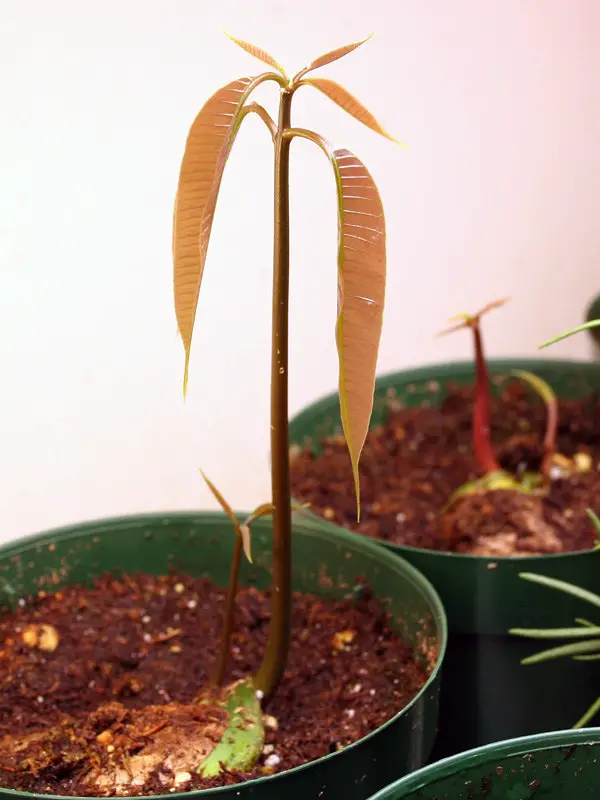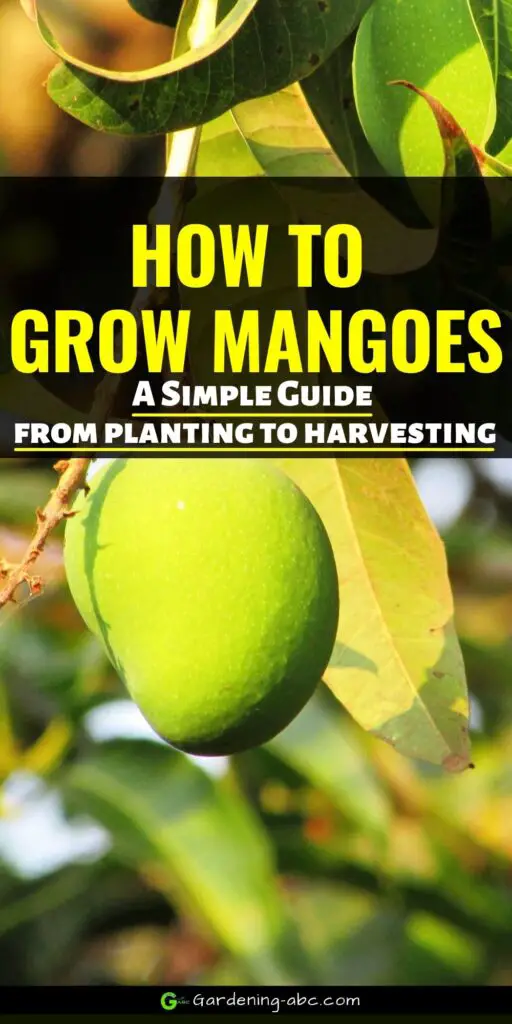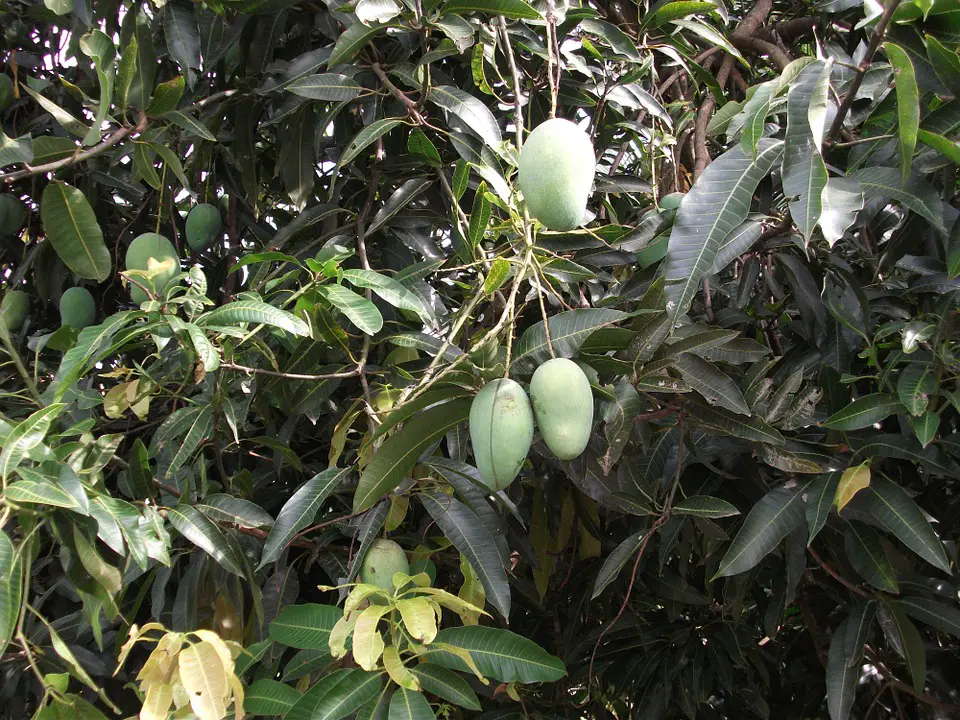We use affiliate links to run our site. When you buy through links on our site, we may earn an affiliate commission, without any added cost to you. Learn more
Do you live in a tropical climate and want to grow your own fresh mangoes? Or maybe you’ve always dreamed of having a mango tree but didn’t know where to start. Look no further! In this post, we’ll give you simple tips for growing mangoes at home, no matter where you live.
A mango tree generally needs a lot of room to grow. But if you don’t have a large free space, you can still grow dwarf mango trees in your house.
Here in this post, we will share with you some useful tips that will help you grow mango trees in your home. Not only will you be able to enjoy delicious mangos whenever you want, but you will also be proud of your green thumb!
There are two ways to grow mango:
- From the seeds,
- From grafting
| Growing From Seeds | Growing From Grafting |
| This is a fun and affordable option, perfect for the curious gardener. Germination is relatively simple, but be aware it can take 7-10 years for a seed-grown tree to fruit. | This method offers a faster path to enjoying your harvest. Grafted trees from nurseries are typically chosen for their manageable height and reliable fruiting, often within 5 years. |

1. Growing Mangoes From The Seeds:
Growing mangoes from the seeds is pretty easy. Peel a ripe mango, and separate (or eat) the pulp. Then wash the remaining hard portion (it contains the seed) with water and let it dry.
Then sow it where you want to plant the tree. Within 2 to 3 weeks you will get the seedlings. In this process, the plants grow really big but the fruiting requires a minimum of 8 years.
Please remember, If you’re growing a tree from seed, the fruits might not be true to the parent plant, It can even be sterile and won’t bear fruit at all.
So if you are growing a mango tree for the fruits always choose a grafted dwarf mango variety.
2. Growing Mangoes From Grafting:
Most of the plants bought from nurseries are grafted, you just need to plant them. In this method, the plant reaches a manageable height and can bear fruit within 5 years. In this process quality of the fruit is almost assured.
Growing a mango tree from grafting is a better choice. You can choose dwarf varieties that you can grow in containers and easily keep an eye on them. Dwarf varieties like ‘Kensington Pride,’ ‘Irwin,’ ‘Haden,’ and ‘Keitt’ are well-suited for container growing.
Climate:
Mangoes are called the king of fruits. It is generally a plant of the tropics. If the surrounding temperatures fall below 30 F, it will become tough for you to grow a mango plant.
Typical weather for growing mangoes is hot summer and cool winter (not very cold). If you live in a place that is more or less of this type; you can definitely try growing mangoes.
Light:
Mango trees need plenty of sunlight. Ideally, 6-8 hours of direct sunlight is a must for mango trees to thrive. So if you have a potted mango tree you have to move it outside. A south-facing window will also work for you if the plant size is small.
When the tree is in the young seedling stage you need to protect it from direct sunlight.
Soil:
The ideal soil for growing a mango tree in pots is nutrient-rich, peat-based potting soil that has excellent drainage. The pH of the soil ideally should be in the range of 5.5 to 7.

Mango Tree Planting:
First, dig a hole double the size of the root ball. Carefully separate the tree and pot without disturbing the roots. Now, put the tree root ball in the hole and fill it in with soil and water.
Give at least 6 to 12-meter spacing while planting. They grow really big and need that much space to grow properly.
If you are planting a dwarf mango tree in a container, choose a large-sized container and plant the rootball in it. With time the rootball will grow bigger just like your plant and you have to shift to a larger container.
If you live in tropical weather, the best time to plant a mango tree is before the monsoon starts. For colder climates, spring is the best time to plant a mango tree.
- 🌳 Mango Majesty Unveiled: Elevate your Mango Tree care with Gardenera’s meticulously crafted Mango Tree Potting Mix, designed to nurture the growth and bounty of your mangoes.
- 🍃 Premium Blend for Optimal Thrive: Our potting mix thoughtfully combines Canadian Peat Moss, lightweight Perlite, nutrient-rich Worm Castings, and well-structured Sand, forming the perfect foundation for your Mango Tree’s flourishing.
How to Water Mango Trees:
If you are growing Mango trees on the ground they don’t require much water. Overwatering can kill your plant. Make sure your soil has enough drainage.
Add a thick layer of mulch around the tree. This will preserve the water beneath the surface and also protect the plant from weeds.
However, if you’re cultivating dwarf mangos in a container, they’ll need regular watering in the first couple of years. Once the tree starts bearing fruit, the water demand reduces considerably and you should only moderately water it during the pre-flowering period.
Fertilizing The Mango Tree:
In the initial years, you need to provide nutrition for the plant from the outside. Apply compost, manure, etc to the soil. These will provide nutrients to the plant organically. As the plant matures you will need a lesser amount of fertilizer.
Maintainance of A Mango Tree:
An average mango tree may live to be a century old if you treat it carefully.
Once the plant gets a little bigger you can think about pruning your mango tree. Pruning is a very good choice for mango trees. Apart from giving space and nutrients to the branches, it also helps to give the plant a proper shape.
They can not tolerate frost. So you need to protect the plant from a cold harsh winter. Take some bubble wrap and cover the pot. Keep your plant indoors during winter.
If you are growing a mango tree in a colder climate, make sure your tree gets as much heat as possible. Use dark color pots that have enough openings at the bottom.
Harvesting Mangoes:
While harvesting mangoes, be careful. The fruit sap can really cause problems (skin problems, allergies) to the body.
Depending on their variety the mature fruits can vary in size and shape. The best time to pick the mangoes is when they are ripe.
But if you have to pick them early (sometimes done with the intent to protect the fruits from birds, bats, and other animals), pack them in paper bags and keep them at room temperature for some time.
The flavor of a ripe mango is always welcomed. Enjoy your vitamin and mineral-packed fruit with friends and family. You can also use the raw ones in making pickles or in salads.
How long does it take for a mango tree to mature and produce fruit?
Mango trees typically take around three to six years to mature and start producing fruit. The exact time frame can depend on various factors, such as the variety of mango, growing conditions, and care practices.
Are mango plants easy to grow?
Mango plants can be relatively easy to grow, especially if you live in a warm and humid climate. However, they do require some specific care practices, such as regular watering and fertilizing, pruning, and pest control measures.
What is the best time of year to plant mango trees?
The best time to plant mango trees is typically in the spring, after the last frost of the season. This allows the tree to establish itself during the warm growing season, and prepare for the cooler winter months.
How do I know if my mango tree is diseased?
There are several signs that a mango tree may be diseased, such as yellowing or wilting leaves, stunted growth, discoloration or spots on the fruit, and the presence of pests or mold. If you suspect your mango tree is diseased, it’s best to consult with a gardening expert or arborist for proper diagnosis and treatment.
Can I grow a mango tree in a container?
Yes, it is possible to grow a mango tree in a container, but it can be challenging. Mango trees can grow quite large and require a lot of space and nutrients, so it’s important to choose the right size and type of container, and provide proper care and maintenance.
What are the best mango varieties for cultivation?
Some of the best mango varieties for cultivation include the Kensington Pride, Irwin, Haden, and Keitt. However, the ideal variety can depend on various factors, such as your location, climate, and personal preferences.
What are the common pests and diseases that affect mango trees?
Common pests that affect mango trees include fruit flies, scales, mites, and aphids. Common diseases include anthracnose, powdery mildew, and black spot.
What are the benefits of using organic practices in mango cultivation?
Organic practices in mango cultivation can help to reduce the use of harmful pesticides and fertilizers, promote healthier soil and plant growth, and produce higher-quality and more nutritious fruit. Organic practices can also help to protect the environment and wildlife.
How do you value-add mangoes and create additional revenue streams?
There are several ways to value-add mangoes and create additional revenue streams, such as processing the fruit into jams, jellies, sauces, and chutneys, or drying and packaging the fruit for sale.
Other options include selling mango seedlings or offering agri-tourism experiences, such as farm tours or fruit-picking events.
Conclusion:
Growing mangoes is not as difficult as it may seem. With a little bit of care and attention, you can enjoy delicious mangoes right at your home. Follow the tips mentioned above and you will be sure to have success in growing mangoes.
So what are you waiting for? Start growing your own mangoes today!
Hope this post is helpful to you. If you like the post don’t forget to share it with others.
Don’t forget to PIN IT

Amazon and the Amazon logo are trademarks of Amazon.com, Inc, or its affiliates.


